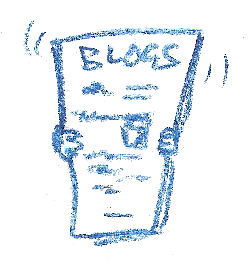Introduction
You don’t always have to visit a blog to see the most recent article. Although it has fallen into disuse to some extent in recent years, there is a way of having the blog posts come to you. All you need are what is called an RSS feed, and an RSS feed reader.
Here's a quick guide to RSS, which you may have seen mentioned on websites and blogs. It's something which makes it very easy indeed to keep up-to-date with your favourite blogs and other types of website.
What does RSS stand for?
The most commonly accepted answer is 'Really Simple Syndication'.
What does RSS let me do?
It makes it easy to do two things really easily. Firstly, it lets you read the articles on your favourite websites all in one place, using an application called a 'feed reader'. Secondly, as an extension of that, it lets you collate the latest posts from several blogs all in one place. It doesn't have to be only blog posts. It could be latest comments on someone's blog, or their most recent tweets in Twitter, or anything else that has an RSS feed.
Taking the first point, it means that you don't have to traipse from one website to another to check if there is anything new: new stuff will show up in your feed reader automatically.
How do I obtain a feed reader?
Just search for the term 'feed reader' and then find one that suits you. You can have one which is installed on your computer, or one that resides on the web. I prefer the latter, because it means it doesn't matter whether you're sitting at your own computer or not when you feel like checking for new content. Some installed feed readers let you synchronise with a web-based one, meaning that you potentially get the best of both worlds.
I use a feed reader called Feedly. I’ve found it to be perfectly serviceable, but recently I’ve started to try out one called Inoreader, which seems to have a bit more functionality (especially if you take out a paid plan).
How do I subscribe to an RSS feed?
If you've installed your feed reader's browser toolbar, you should be able to do so by clicking on 'Subscribe', if the blog or website has been set up to allow this. Otherwise, look for an icon like this:
"LogoRSS" by Ricardo Moctezuma is licensed under CC BY 2.0
and click on it; your feed reader should do the rest. If it doesn't, right-click on the icon and select the menu item which reads 'Copy link location' (or similar), open your feed reader, and then paste the link into the New Subscription box. Don't worry: it's all a lot simpler and quicker than it sounds.
How do I read new articles?
Just open your feed reader and see what, if anything, has been added to the various websites since you last looked.
Conclusion
RSS makes it easy for you to keep up with lots of reading in a shorter period of time than would probably otherwise be the case, because you're not racing all over the internet from site to site.
If you’re a writer, and have a blog, I strongly recommend that you make it easy for visitors to find your RSS feed. Either do that through displaying the RSS icon (with a link to the RSS feed) in a prominent place, or have a “Subscribe” page or area on your website.
If you're a teacher, it can also benefit your students. For example, if your school uses a virtual learning environment (VLE) you could set up areas for students to visit where the latest headlines from a range of websites are displayed. That could be used purely for reference, or you could incorporate it into lessons. For example, the first five or ten minutes of each lesson could be spent discussing what's new in the world of hospitality and catering, or in business and finance. At the risk of sounding clichéd, the uses for RSS are limited only by your imagination.
If you’d like to have my articles delivered to your phone or tablet via an RSS feed reader, here are my RSS feeds:
I hope you have found this useful.
An earlier version of this article was published in 2010.
If you found this article interesting, why not subscribe to my newsletter, Terry Freedman’s Books Bulletin?

